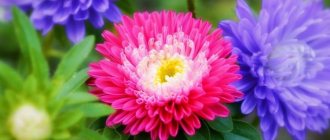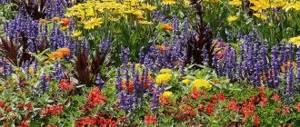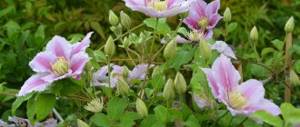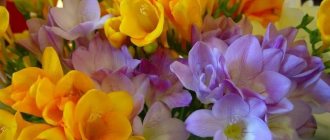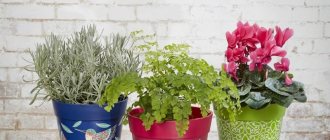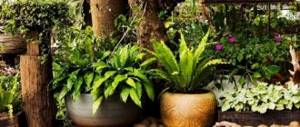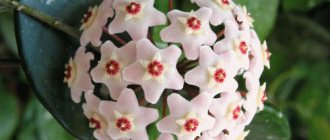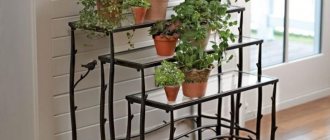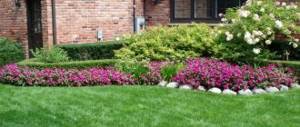|
Until recently, the container method of vertical gardening was new to us, but now everyone has become accustomed to luxurious hanging baskets of petunias, calibrachoa, fortunia, morning glory, sweet potato and purslane in urban landscaping and are happy to use this technique in personal plots, small gardens and in the design of balconies . For container growing, annuals are mainly used. This is very convenient - we removed them in the fall and put the empty pot in storage. However, container plantings are also acceptable for compact perennial plants, which, in monoculture or in combination (including with annual plants), make it possible to create extraordinary, bright, and sometimes exotic compositions.
Planting perennials or even small shrubs in containers has the same advantages as for annual plants - ease of care (you only need watering and fertilizing), almost complete absence of weeding, and mobility. For example, when guests arrive, you can collect several pots of plants from around the garden near the gazebo and patio for relaxation and create the mood of a real holiday. However, there is one significant drawback - the need to transplant perennial plants into the ground, or dig in pots in the garden or winterize them in a house, cool greenhouse or basement. But beauty, as we know, is worthy of small sacrifices. In addition, for some desirable but heat-loving plants, overwintering in a frost-free environment is the only way to survive frosts. If you are not afraid of this aggravating circumstance, let’s look at the possible assortment.
Bergenia with heuchera | Brunnera with herbs |
Houseplants
Despite the fact that for many subtropical plants (citrus, myrtle, some ornamental foliage) it is recommended to move them to the garden for the summer, which undoubtedly enhances growth in the fresh air, we do not recommend doing this. If you decide to use any indoor plants in a container garden composition, it is better to root cuttings or young rosettes in advance, from February, and use the plants as disposable ones (about cutting technology, see the article Cuttings of indoor plants at home). You may want to buy something specifically to implement your intended design.
Agave | Agapanthus umbellata |
For placement in sunny places, use drought-resistant agaves, Kalanchoe Blossfeld (which blooms beautifully in the open air all summer). With slight shade and constant moderate soil moisture, plectranthus, chlorophytum crested, aucuba, fatsia japonica, hemigraphis alternating, decorative deciduous and flowering begonias, hypoestes phyllospica, southern cordyline, irezine, helichrysums, ivy, tradescantia, pelargonium, tolmia, calla lilies, rosemary are suitable , large-fruited cypress. However, the latter can be replaced without damaging the composition with annual kochia and, if necessary, given shape by cutting.
Japanese akuba with ivy and Wittrock violet | Begonia ampelous |
Calceolaria |
Perennials
Let's start our conversation about perennials with spring-flowering plants. First of all, these are bulbous plants, but they need to be planted in the usual time - in the fall, and buried in pots in the garden. However, this is also a solution for those who bought, for example, tulip bulbs at an inopportune time - at the end of winter and beginning of spring, although still try to purchase the bulbs on time so that at the end of the season you get good replacement bulbs, and not small babies. They are good to combine with biennials - daisies, forget-me-nots, Heiranthus Cheri, Wittrock violets, and even better - with perennial horned violet. But such a composition, due to the short flowering of the entire community, will still require either replacement with annual plants or replanting with perennials - for example, garden geraniums.
Tulips and turfgrass | Bergenia with hellebore on a background of wormwood |
An interesting combination is obtained during the flowering period when bergenia and hellebore are used together in planting. Other perennial crops for containers include an unlimited selection of varieties of heuchera, tiarella, compact hosta, gravilates, aromatic plants with decorative aromatic foliage - English and French lavenders, varietal oregano (for example, yellow-leaved Aurea), creeping and lemon-scented thymes, lemon balm , decorative deciduous varieties of medicinal sage and beautifully flowering varieties of oak sage. By the way, you can pinch spicy herbs little by little for summer teas, this will only enhance the formation of new shoots. Ferns will be good for shady conditions - even those species that do not winter well here can be used in pots and flowerpots.
Oak sage, Armeria maritima, Oregano Aurea and ivy | New Zealand flax with purple tenacity |
Oak sage and lavender | Heuchera, spotted lariat, spurge, Wittrock violet |
Undemanding juveniles have long established themselves as wonderful container plants. For lovers of rock gardens, the question of choosing plants will not arise at all - the most unpretentious of the “alpine gardens” are perfect for container growing, for mini rock gardens.
Rejuvenated | Rejuvenated |
Plastic bottles
Don’t rush to throw away your plastic soda bottle; it’s better to use it to make a new pot for house plants. Cut the bottom of the container to a height of 7-10 centimeters. Use an awl to make several holes in the bottom for drainage. Degrease the surface and cover the bottle with acrylic paint.
Come up with an original pattern or download a stencil on the Internet. If you wish, you can even draw an entire landscape, so don’t be afraid to get creative. Secure the picture with clear acrylic varnish to prevent the picture from cracking.
You can also cut out the top edge of the pot in the shape of animal ears, for example, a bunny or a teddy bear. Draw eyes, a nose, a muzzle and a mouth on them, or glue ready-made elements onto double-sided tape. The plant planted inside the bottle will serve as a kind of animal fur. This pot will decorate any children's room.
Shrubs
Pot growing is suitable for miniature and patio roses, some floribundas and small ground cover varieties (Cinderella, Goldjuwel, Charmant, Fortune, Coco, Knips, Mainaufeur, Neon, etc.). Planting roses with lavender, hyssop, Steller's, Schmidt's wormwood or hybrid Powis Castle look wonderful (the latter is winter-hardy only down to -20°C, winters better in the basement). For planting in containers, you can use gift patio roses, sold in all flower shops. They should be treated more as throwaway plants, although some varieties are hardy enough to last for several years when covered.
Boxwood and roses | Pieris, tulips, rhododendron |
The classic European version - boxwood cut into a ball or cone - in a pot is acceptable only in a slight shade, otherwise it will burn in the sun. For the winter it needs to be dug in and covered using a frame method. Do the same with evergreen euonymus Fortune and Japanese, or move them to a cool windowsill. It is also traditional to use heathers in containers. A beautiful mat in a low flowerpot placed in the shade is formed by the winter-green subshrub pachysandra apex (you can combine the main species with the Green Carpet variety, which is distinguished by its light green foliage, or the variegated Variegata variety).
More unpretentious and fairly drought-resistant shrubs that will feel great in container compositions are bright small varieties of spireas (Golden Princess, Gold Flame, Little Princess) and Thunberg barberries (Admiration, Goldalita, Tiny Gold, Golden Ring, Kornik, Rosey Rocket and etc.). Barberries should be used only when the container is located away from paths and there is no danger of getting caught on its thorny branches, especially for children. They can be trimmed.
Spiraea, hosta, bright violet of Wittrock | Derain with mallow, lined with lobelia and fortunia |
White Ivory Halo with white-edged foliage grows slower than other varieties, is not tall and tolerates pruning well, ideal for growing in large flowerpots. In the sun or partial shade, Stephanandra incisifolia will give cascading growth (its Crispa form with more rugged foliage is especially interesting).
Among heat-loving shrubs, you can plant the graceful variegated and low Keria japonica Picta. There is a compact buddleia variety called Buzzy for container growing. For the winter, it is cut off and covered with sand and wood ash. The black elderberry Black Lace has a wonderful crown with purple openwork foliage and pinkish airy inflorescences, which combines perfectly with the yellow-leaved forms of any plants, and no worse with green ones.
Black elderberry Black Lace with heuchera and other plants | Black elderberry Black Lace with heuchera |
Clematis lovers can plant early large-flowered varieties of the Boulevard series adapted for container keeping - Angelique, Oоh-la-la, Chantilly, Parisienne, double Kaiser, blooming in early summer on last year's shoots, and under favorable conditions - again in July-August on the current year's shoots . They belong to the 2nd group of pruning: in the fall, weak and dead shoots are removed, the rest are trimmed, leaving 10-15 nodes for cover. Although varieties that can be completely cut off before winter are more convenient for our area, container growing allows us to provide them with warmer shelter.
Clematis lined with fuopsis | Clematis with petunia and euphorbia Diamond Frost |
Dimensions
The size of an outdoor pot depends directly on the area of the site or a separate area that needs to be supplemented with fresh flowers.
A large and bulky flowerpot in a small area will attract a lot of attention and look out of place and too intrusive. A small flowerbed on a long plot will get lost and will look inconspicuous. Most importantly, the flowerpot should emphasize the beauty of the site.
The size and location of the flowerpot depends on other plants on the site. For example, it is better to install large outdoor pots next to large tall trees, and miniature and light flowerpots near bushes.
For large flowerpots, two or three types of plants are needed. Violets are great for low flowerpots near garden paths. These unpretentious, bright and small flowers are ideal for decorating stairs, playgrounds and balconies.
We suggest you familiarize yourself with Propagation of juniper by cuttings and layering
Cereals and herbs
Their number of grasses is most acceptable; they do not grow very wide, are low, and have interestingly colored foliage. For example, large manna Variegata, glaucous fescue, wolf sedge Amazone Mist and sedge Frosted Curles with bluish very narrow foliage, bronze shaggy sedge Zora and sedge shaggy Bronzita. In a composition with moisture-loving plants, Imperata cylindrica will become a bright spot of color. For those who have conditions for overwintering plants indoors or in a greenhouse, you can try the dark Ophiopogon Nigrescens or a wonderful plant - Hakonechloa major, which has varieties with yellow stripes on the leaves. Hakonechloa looks great alone, covering the flowerpot with a semicircular cap of hanging foliage. Often annual grasses are planted as a central vertical - purple-leaved pennisetum Red Baron or yellow-leaved pennisetum gray Jade Pricess F1, but this is for fairly large flowerpots.
Composition of begonias with cereals | Composition with cereals |
Nice Additions
In any composition, be it a bouquet, a flower garden or a container, there are accent and staff plants; the same laws of composition and color harmony work (read about them in the article Laws of Artistic Disorder). As fillers, it is best to use silvery (annual Cineraria maritima, Helichrysum petiolate) green plants, or those with white flowers (for example, Lobularia marine). Decorating the edges of the container with hanging plants is of no small importance. Perennial ivy-shaped budra Variegata is perfect for this purpose (it is well preserved at home provided there is sufficient lighting, but you can replace it with a local wild species that can be found in any garden), dichondra, annual cascading lobelias, hybrid verbenas, morning glory sweet potato, which has varieties of different foliage colors, bacopa with white and lilac flowers. And where you need to add a little sun, the best choice is bidens feruleleaf or sanvitalia (about other hanging annuals, see the article New hanging plants for vertical gardening).
Wittrock violet with ivy bud Variegata | Petunias Variegata |
Annuals and biennials can not only serve as a complement to a container “bed”, but also as bright spots that draw attention to themselves. You will find such examples in the photographs.
Some growing tips
Pots with drip irrigation |
Whatever plants you choose for your container garden - drought-resistant or moisture-loving, the most pressing issue in care will be the provision of moisture. If it is not possible to monitor the condition of the soil daily, make sure in advance that the plants do not need anything. Keep in mind that in wooden and unglazed clay containers the soil dries out faster than in plastic ones. But you can make old clay pots grow moss and partially get rid of this drawback. There are beautiful terracotta-like containers made of rubber-like porous material that are difficult to distinguish from clay ones by appearance, with the advantage that they are very light and easy to carry. Nowadays there is a wide selection of plastic flowerpots on sale, equipped with a drip irrigation system - the water in them is consumed gradually, and the soil moisture is easily controlled.
If you cannot afford expensive flowerpots with drip irrigation, it is especially important to properly prepare the substrate. As a base, you can use high-quality commercial soil for flowering plants or a universal one. They have a common drawback - they are made on a peat basis and dry out quickly. To adapt it for container plants, you must add loam (good garden soil) or compost containing clay inclusions. The soil should remain homogeneous, light and breathable. There are also special additives for retaining moisture - clay granules "Ceramis" and Hydrogel. It is better to pre-soak the ceramic, and add the Hydrogel dry and soak it together with the soil.
In order for plants to develop well and bloom luxuriantly, they need good regular nutrition. If purchased soil is used for planting, it already contains a certain amount of fertilizers, however, they are quickly exhausted by the plants in the limited volume of the container. Therefore, fractional fertilizing is done every 2 weeks (in late spring and early summer - with complex fertilizers with a predominance of nitrogen, and from July - with a predominance of potassium and phosphorus). It is even more convenient to use high-quality long-acting complex mineral fertilizers, which are mixed into the soil or incorporated into the soil around the plant 2 weeks after planting. The leader among them is the Osmocote brand - this is a capsule fertilizer that gradually releases elements through osmotic processes. Also, granular fertilizers of the Pokon, Greenwold, Seramis brands have a prolonged effect, and an economical option is Fertica. Japanese organic fertilizers “Aburakasu” have an excellent effect; their green “carnations” just need to be stuck into the ground 2 weeks after planting, and you can forget about fertilizing for the whole season.
Street flowers in pots as a decorative element of the landscape
Many people want to have a house outside the city.
This is an opportunity to spend a weekend closer to nature, in peace and solitude, away from the bustle and crowded streets. An obligatory component of a personal plot is outdoor plants. Someone purchased a building on an already green area and simply made adjustments or additions, but more often the arrangement is done from scratch. If it is not possible to create a real flower garden, then you can always create a greenhouse from flowers in pots
Not a single design development, created by a professional or an amateur, is complete without flower beds. They make the structure bright and interesting and bring vibrant natural colors into the surrounding design. Flowers are an uncomplicated, unique way to decorate the most modest landscape. And it is accessible to everyone: if the composition of the soil, lack of space or any other reasons do not allow you to set up a flower garden, you can create a real greenhouse from flowers in pots.
Even if you don’t have a country house, you shouldn’t deprive yourself of the pleasure of being among flowers in the summer. Pots with plants can be mounted on the outside of the balcony, loggia, and even on the window slope. In specialty stores it is easy to find both the containers themselves and various devices for hanging and installation. It is possible to purchase a pot with a ready-made flower, but you can go from a seed or sprout to a blooming avalanche.
The finished plant option seems simpler only at first glance. It is important to organize adaptation correctly, otherwise the plant will lose its attractiveness. The second way is longer, but with proper care, the beginning of the growing season will bring a lot of pleasure.
Flower pots can be used not only in a country house, but also in a city apartment
The desire to decorate not only the ground part with flowers, but also the upper tiers of the site has led to the popularity of hanging versions of pots. In this position, the most suitable flowers for pots are hanging ones. It is the cascading floral mass that creates an interesting decorative effect.
The upper tiers of the garden plot can be decorated with flowers in hanging pots
Those who want to not only decorate the area around the house, but also get benefits, can plant... berries and vegetables in hanging pots. Strawberries are a great option. During the flowering period, it creates an original green cap of large leaves, decorated with white or pink flowers. The berries ripening on the stems fall, forming a strawberry “rain”.
Cucumbers of all types, as well as long-stemmed tomatoes, can also be useful decorations for your garden. Chili peppers look original in hanging flowerpots. It needs to be planted densely, then both the green mass and the ripening fruits will look more impressive.
You can plant not only flowers, but also strawberries in hanging pots
For those to whom the sense of commercialism is completely alien, it is worth using hanging flowers for pots. These are plants that are characterized by drooping or creeping stems. The flowers are small or medium-sized, densely located on the stems. Among the ampelous species there are few non-flowering species.
Ball-shaped plants are an excellent design element for garden plots. They occupy a special position in terms of visual perception. Hanging lamps direct the eye vertically, while those planted in the ground direct the eye horizontally. Ball-shaped ones unite directionality, focusing attention on themselves.
This is not to say that the choice of spherical plants is great. The most common option is thuja. Evergreen balls planted in flowerpots decorate alleys, facades of buildings, entrances to gazebos, etc. There are also several types of ornamental shrubs that are planted in containers. Their crown is formed into a ball by cutting.
Among the spherical outdoor flowers in pots, the name of which is familiar not only to botanists, it is worth noting the chrysanthemum. Its dwarf type (namely, this is the one that gives the appropriate shape) has small round flowers of various colors and shades. If thujas delight the eye all summer, chrysanthemums will reach their decorative value only by the end of August - beginning of September.
Globular plants have always been an excellent element in the design of personal plots
Flowers in pots for the street can be purchased at the store. Like any product, hanging flowers can be ranked according to the degree of decorativeness, stability and unpretentiousness, and even according to the features of their functional purpose.
The plant rating below is compiled precisely on the basis of the listed indicators, to which the price is added.
Begonia is the most capricious hanging plant
5. In fifth position is ivy. It creates an excellent backdrop for plants with bright flowers. Different types of ivy have differences in the color of the leaves: dark green, green with white streaks, green with white splashes, etc. The plant is perennial, does not require special care, and feels good even in a shaded place.
4. Next in the ranking is begonia. One of the most capricious ampelous plants. Does not tolerate direct sunlight, drafts, requires abundant watering, “suffers” when changing location. With proper care, it pleases with bright colors of warm shades.
3. The third result is for lobelia. Requires regular watering and loves warmth. The flowers are small and can be white, blue or pink. This plant can also be planted as a border.
2. Vervain is very close to the top of the ranking. It feels quite comfortable in direct sunlight; moderate but regular watering is necessary. The buds come in different colors: white, yellow, red, blue.
Verbena buds come in a variety of colors: they are blue, white, red, yellow
1. The place of the winner has been occupied by petunia for a long time. The variety of species (with small, large, plain, multi-colored buds) and unpretentiousness have made it a favorite of many gardeners and florists. A large number of photos of petunias in pots, which are a bright and original decoration of areas in design developments, are a clear confirmation of leadership.
Even the most drought-tolerant flowers need regular watering.
- Even the most drought-resistant specimens require regular watering. Moistening the soil from time to time will certainly have a negative impact on the growing season.
- On hot days, watering can be increased for all plants. The root system is located in a limited amount of soil; the plant cannot independently obtain additional moisture.
- Mulching should be used to retain moisture.
- Once every two weeks it is necessary to fertilize the plants. If this is not done, in the second half of summer the intensity of flower development will noticeably decrease.
- Be sure to shape the crown by cutting off excess shoots.
- Fading buds must be removed. This will not only ensure the aesthetics of the plant, but will also eliminate unnecessary waste of nutrients, which will help stimulate growth.
- Every spring, hanging plants must be planted in fresh soil mixture.
In hanging flowers for pots, it is necessary to form a crown by cutting off excess shoots

